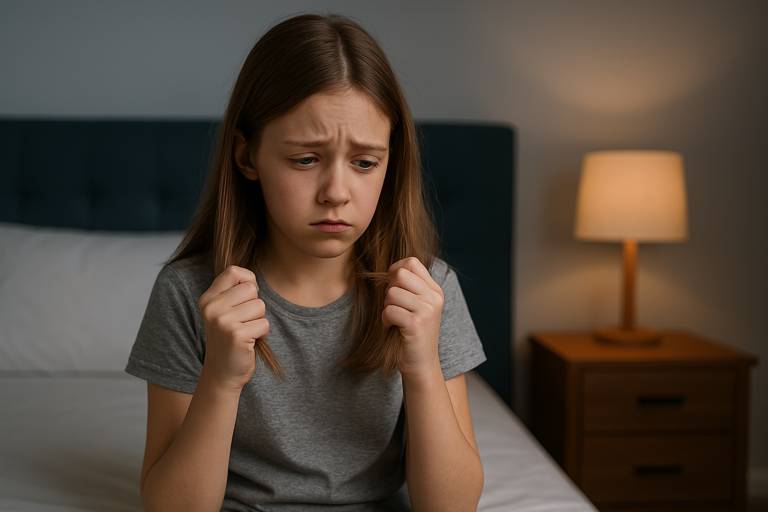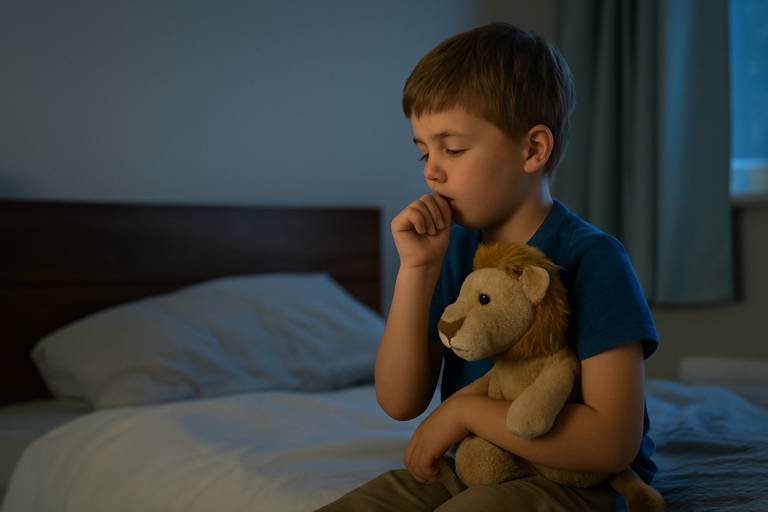Behavioural problems in children can include habits like nail biting, hair pulling, thumb sucking, or even certain tics. These behaviours often appear when a child feels overwhelmed, bored, anxious, or needs comfort. While some habits fade over time, others become persistent, disrupting daily life and knocking a child’s confidence.
Understanding Behavioural Problems in Children
Behavioural problems in children can take many forms. Two increasingly common examples are trichotillomania, which involves pulling out hair, and an over-reliance on phones or tech.
Children with trichotillomania may not even be aware they are doing it, especially during moments of stress or boredom. The behaviour can quickly become compulsive, leading to distress, embarrassment, and even physical damage.
Phone or tech addiction can also be a sign that a child is struggling emotionally. What starts as screen time for fun or comfort can turn into avoidance, isolation, and dependency. Children may become irritable when asked to switch off, or feel anxious when separated from their device. In both cases, the behaviour serves as a coping mechanism, offering short-term relief from deeper emotional needs.

Repetitive behaviours often serve a purpose in a child’s inner world. They might bring comfort, offer a way to self-soothe, or help them manage difficult feelings. Children may not even realise they are doing it. Some chew their sleeves when concentrating, others twirl their hair when nervous. Over time, these small actions can become automatic, and harder to stop.
Parents sometimes feel frustrated or helpless when a behaviour persists despite their efforts. But punishing or drawing attention to the behaviour can make it worse, especially if it is linked to anxiety or emotional discomfort.
Why These Habits Are Hard to Shift
Children’s behaviours are often driven by the subconscious mind. Even when they want to stop, they may struggle to control the urge. That is because the behaviour has become a pattern linked to how their brain processes stress, emotion, or even boredom.
“When children feel unsettled, their minds look for ways to restore calm. A simple behaviour can become a shortcut to comfort. Over time, it sticks.”
Paul White, founder of TISPH
Because children live in their imagination, they can access this part of the mind quickly and easily. This makes them especially well-suited to hypnotherapy, which speaks to the subconscious using metaphor, story, and gentle suggestion.
How Hypnotherapy Can Help
Hypnotherapy for behavioural problems in children helps by making them aware of the behaviour in a calm, supportive way. Using imagery, imagination, and child-friendly techniques, the therapist guides the child to understand why it started and how to respond differently.
Rather than forcing change, hypnotherapy gently encourages the brain to choose a new, healthier response. The process is enjoyable and empowering, often involving metaphors, creative stories, or visualisations that speak directly to the child’s inner world.
Because children respond quickly to imaginative approaches, they often take half the number of sessions an adult would need for the same issue.

A Story of Success
A nine-year-old boy came to therapy after his thumb sucking had continued into late primary school. He wanted to stop but found it comforting, especially at night. His parents were supportive but unsure what else to try.
In just a few sessions, the therapist helped him imagine a wise animal guide who reminded him he was safe and strong, even without thumb sucking. He practised this calming image at bedtime, and within three weeks, the behaviour was gone. He was proud, and so were his parents.
What to Expect from Hypnotherapy
Sessions are creative, calm, and focused on the child’s strengths. The therapist may use drawing, storytelling, play, or gentle guided visualisation. Children are never judged or pressured. Instead, they are helped to understand their behaviour and feel confident about changing it.
- Many children experience noticeable change within just a few sessions
- Parents are supported with understanding, reassurance, and tips to help at home
Children often enjoy the sessions, which feel more like imagination games than therapy.
Why Choose a TISPH-Qualified Therapist?
TISPH-trained therapists are specialists in working with children. They are trained in child development, safeguarding, and paediatric hypnotherapy techniques. This means they know how to connect with children in ways that feel safe and engaging.
You can find a qualified therapist using our Find a Hypnotherapist page.
Common Questions
Does hypnotherapy force the child to stop the behaviour?
No. The process is about helping the child feel safe and motivated to make changes. It is gentle, collaborative, and positive.
What if my child goes back to the behaviour later on?
Sometimes behaviours return during times of stress. A short top-up session is usually enough to remind the brain of the new pattern.
Can hypnotherapy help with all types of behavioural problems in children?
Hypnotherapy can be effective for a wide range of behavioural problems in children, especially when those behaviours are driven by emotional or subconscious patterns. Each child is different, so the therapist will tailor the approach to the specific behaviour and what is motivating it.
How can I tell if behavioural problems in children are linked to something deeper?
When behavioural problems in children become more frequent, intense, or begin to affect their daily routine or emotional wellbeing, it could indicate something deeper at play. Hypnotherapy can help uncover these underlying causes and provide gentle, effective strategies for change.
How do I know if my child’s behaviour is a normal habit or a deeper issue?
All children develop habits, but when a behaviour becomes frequent, distressing, or begins to affect daily life, it may be time to seek support. Hypnotherapy can help uncover what might be driving the behaviour and gently guide the child toward healthier patterns.
